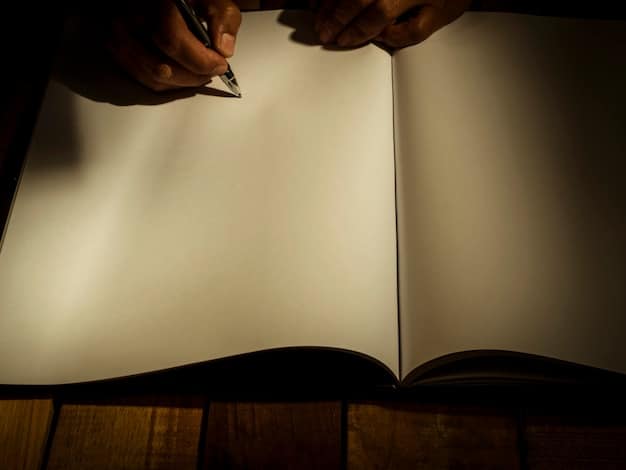The Ultimate Reading List to Beat Writer’s Block in 30 Days

The Reading List That Will Help You Overcome Writer’s Block in 30 Days features a curated selection of books designed to reignite creativity, improve writing skills, and instill discipline, providing a structured approach to conquer writer’s block within a month through targeted reading and actionable insights.
Writer’s block can be a daunting obstacle for any writer, stalling progress and diminishing motivation. But what if the solution was as simple as picking up a book? This reading list is designed as The Reading List That Will Help You Overcome Writer’s Block in 30 Days, offering actionable advice and inspiration to get your creative juices flowing again.
Unlocking Creativity: Why a Reading List?
Why turn to reading when facing writer’s block? Reading exposes you to diverse writing styles, narrative structures, and thematic approaches. It’s like a masterclass in writing, taught by countless authors across genres and generations. A well-curated reading list can provide targeted solutions for specific writing challenges.
Exposure to New Ideas
Reading introduces you to fresh concepts and perspectives that can spark new ideas for your writing. It broadens your understanding and fuels your imagination.
Learning Different Writing Styles
By immersing yourself in various writing styles, you can learn new techniques and incorporate them into your own writing. This helps in developing a unique voice and style.
- 📖 **Enhances Vocabulary:** Consistent reading inevitably expands your vocabulary and helps you articulate your thoughts more precisely.
- ✍️ **Improves Grammar and Syntax:** Reading reinforces correct grammar and sentence structure, leading to better writing skills.
- 💡 **Boosts Creativity:** Exposure to different stories and ideas can stimulate your imagination and inspire creativity.
Ultimately, a reading list is a proactive approach to combat writer’s block. It offers a structured path to improvement, providing you with the tools and inspiration needed to overcome creative hurdles.

Week 1: Reigniting the Spark – Inspiration and Ideas
The first week focuses on reigniting your passion for writing and opening your mind to new ideas. This involves picking books that are inspirational and thought-provoking.
“Bird by Bird” by Anne Lamott
This book is a classic for a reason. Anne Lamott offers practical advice on the writing process, filled with humor and wisdom. It’s a comforting guide for anyone feeling overwhelmed by a writing project.
“Big Magic” by Elizabeth Gilbert
Elizabeth Gilbert explores the nature of creativity and encourages readers to pursue their passions without fear. It’s an empowering read that can help you overcome creative anxieties.
- 🔑 **Key Takeaway:** Cultivate a mindset of curiosity and openness to new ideas.
- ✍️ **Actionable Advice:** Start a journal to capture spontaneous thoughts and observations – you never know where they might lead.
- ✨ **Inspiration:** Seek out environments and experiences that ignite your creativity.
By the end of week one, you should feel a renewed sense of enthusiasm for writing and a wealth of new ideas to explore. Remember, the goal is not to judge your ideas but to gather as many as possible.
Week 2: Honing the Craft – Skill Development
Having rekindled your inspiration, the second week transitions towards skill development. The focus shifts to books that offer specific writing techniques and strategies.
“On Writing” by Stephen King
Part memoir, part masterclass, Stephen King shares his insights on writing, from the basics of grammar to the art of storytelling. It’s a candid and practical guide for writers of all levels.
“Self-Editing for Fiction Writers” by Renni Browne and Dave King
This guide provides invaluable advice on how to revise and polish your work. It covers everything from plot and character development to sentence structure and word choice.
- 🛠️ **Technique:** Focus on one specific writing skill per day, such as dialogue, description, or pacing.
- 📝 **Exercise:** Rewrite a scene from one of your favorite books, paying close attention to the author’s techniques.
- 🎯 **Goal:** Practice consistently to improve your technique.
Week two is all about refining your skills and filling in any knowledge gaps. By focusing on specific techniques and exercises, you can make measurable progress in a short amount of time.

Week 3: Building Discipline – Establishing a Routine
Creativity is important, but consistency is key to overcoming writer’s block. Having developed your skills, the third week emphasizes building discipline and establishing a writing routine.
“The War of Art” by Steven Pressfield
Steven Pressfield identifies the forces that hold us back from our creative pursuits and offers strategies for overcoming them. It’s a motivational book that can help you break through procrastination and self-doubt.
“Atomic Habits” by James Clear
James Clear provides a framework for building good habits and breaking bad ones. It’s a practical guide for establishing a consistent writing routine.
- ⏰ **Schedule:** Dedicate a specific time each day to writing, even if it’s just for 15 minutes.
- 🎯 **Set Goals:** Establish realistic writing goals for each week.
- 🏆 **Celebrate Progress:** Reward yourself for achieving your weekly goals.
Week three is about transforming your writing from a sporadic activity into a consistent habit. By building discipline and establishing a routine, you can maintain momentum and overcome writer’s block more effectively.
Week 4: Expanding Horizons – Exploring New Genres
With a solid foundation in place, the fourth week is about expanding your horizons and experimenting with new genres. The goal is to challenge yourself and discover different dimensions of storytelling.
“Steering the Craft” by Ursula K. Le Guin
Ursula K. Le Guin offers insights on various aspects of writing, from point of view to voice and style. It’s a comprehensive guide for exploring different modes of storytelling.
A Book from a Genre You Don’t Normally Read
This week, pick up a book from a genre that you’ve never explored before. Whether it’s science fiction, historical fiction, or poetry, stepping outside of your comfort zone can inspire new ideas and techniques.
- 🌍 **Genre Exploration:** Select genres that are completely different from your usual preferences.
- ✍️ **Writing Exercises:** Try writing a short story or poem in the style of your chosen genre.
- 💡 **New Perspectives:** Discover new perspectives and approaches that can be applied to your writing.
Week four is about broadening your horizons and pushing your creative boundaries. By exploring new genres, you can discover new storytelling possibilities and unlock fresh perspectives.
Beyond the Reading List: Continued Growth
Completing this reading list is just the beginning of your journey towards overcoming writer’s block. Here’s how to continue growing as a writer.
Join a Writing Community
Connecting with other writers can provide support, feedback, and inspiration. Look for local writing groups or online communities where you can share your work and receive constructive criticism.
Attend Workshops and Seminars
Workshops and seminars offer opportunities to learn from experienced writers and hone your skills. Check out local writing centers or online platforms for upcoming events.
- 🤝 **Networking:** Building relationships with other writers can lead to collaborations and opportunities for growth.
- 🚀 **Continued Learning:** Attend workshops and seminars to stay updated on the latest writing trends and techniques.
- 💖 **Community Support:** Gain support and encouragement from fellow writers in your community.
The journey to becoming a better writer is a lifelong pursuit. By continually seeking new knowledge, connecting with other writers, and practicing your craft, you can overcome writer’s block and achieve your creative goals.
Personalizing Your Reading List Journey
While this list offers a structured approach, tailoring it to your specific needs enhances its effectiveness. Recognize that overcoming writer’s block is a deeply personal process, and what works for one writer might not work for another.
Identifying Your Specific Blocks
Before diving into the reading list, spend some time identifying the specific reasons behind your writer’s block. Are you struggling with plot development, characterization, or simply getting started? Understanding the root cause of your block will help you choose books that address these issues directly.
Adapting the Pace and Order
Feel free to adjust the pace and order of the reading list to suit your schedule and preferences. If you find a particular book resonates with you, spend more time with it. If a book isn’t helpful, move on to the next one without feeling obligated to finish it.
- 📅 **Flexible Scheduling:** Adjust the weekly schedule based on your availability and progress.
- 📚 **Selective Reading:** Focus on the books that are most relevant to your needs and interests.
- 📝 **Personalized Exercises:** Adapt the writing exercises to address your specific writing challenges.
Remember, this reading list is a guide, not a rigid prescription. Personalizing the journey ensures that you are getting the most out of it and making meaningful progress towards overcoming writer’s block.
| Key Point | Brief Description |
|---|---|
| 💡 Inspiration | Reading expands your perspectives and sparks new ideas for stories. |
| ✍️ Skill Development | Hone writing skills by analyzing techniques from various authors. |
| ⏰ Routine Building | Establish a consistent writing schedule to overcome procrastination. |
| 🌍 Genre Exploration | Explore new literary territories to unlock fresh storytelling possibilities. |
Frequently Asked Questions
▼
Allocate at least 30 minutes to an hour daily for reading. Consistency is key, so make it a routine that fits into your daily schedule for optimal learning.
▼
Not every book will resonate, and that’s okay. If a book isn’t working for you, move onto the next one. The goal is to find material that inspires and aids your writing.
▼
Absolutely. Personalize the list with books that align with your interests and address your specific writing challenges. This adaptability enhances the reading experience.
▼
Take notes, highlight key passages, and journal your thoughts as you read. Applying what you learn directly to your writing projects ensures retention and application.
▼
Yes, the principles and techniques in these books are universal. However, consider supplementing the list with books specific to your writing genre for targeted insights.
Conclusion
Embarking on The Reading List That Will Help You Overcome Writer’s Block in 30 Days is a powerful step toward reigniting your creativity and building a sustainable writing practice. By immersing yourself in diverse literary works and adapting the journey to your personal needs, you’ll not only overcome current blocks but also equip yourself with lasting strategies for continued growth, making every writing endeavor an opportunity for success.





